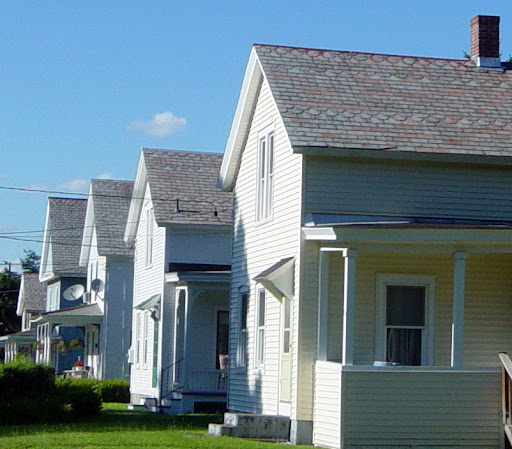Slate roofs are commonplace around Bennington, VT - you find them on mansions, cottages and sheds.

The slate roof here is just one more flourish on an exuberant Queen Anne Victorian.

A slate roof on a garage. Many roofs are laid like this, with no pattern.
The history of slate use in BenningtonThe slate quarries are just up the railroad line in Rutland County, Vt., and Washington County, NY. From the 1800's to the 1920's, slate was the roof of choice. Slate patterns vary by town. In Bennington, many roofs have the same pattern of curved and straight slate, although the number of scalloped rows may vary.

Row of houses for mill workers, with slate roofs using rows of scalloped slate Scalloped shingles become half circles, scales, when that's all there is. This roof is on the same street as the ones shown above.
Scalloped shingles become half circles, scales, when that's all there is. This roof is on the same street as the ones shown above.Brattleboro, Vt. roofers laid their slate in a different pattern, a double overlap:

The Creamery Covered Bridge, just off Rte 9 in West Brattleboro, has a double-overlap roof like this one.
Slate is both strong and attractiveGood slate lasts at least 150 years, poor slate only 75 years. The underlayment, flashing, and nails will wear out well before before the stone, so slate pieces were often reused.
As an added decorative bonus, slate comes in various colors, and pieces split from the same block will have gradations of color. Different quarries will also have different shades and intensities of a similar color.
 Used slate showing the range of color - even in slate from the same quarry. The gray layer is sloughing off on the furthest left piece, revealing a reddish layer underneath.
Used slate showing the range of color - even in slate from the same quarry. The gray layer is sloughing off on the furthest left piece, revealing a reddish layer underneath.
Note double nail holes on all but one (indicating that those pieces have been used twice) and the vertical lines showing how the next layer of slate was laid upon these. The brown on the top half is dirt, and the little swirls are lichen.
 Here are at least 4 different slate colors. The green pieces are probably patches. Some of the darkish red slate is also sloughing off and chipping with age.
Here are at least 4 different slate colors. The green pieces are probably patches. Some of the darkish red slate is also sloughing off and chipping with age.Red slate has always been in short supply, and is therefore the most expensive. In 1879 three quarries produced red slate, but today there is only one.

a red slate roof on a company's headquartersSome owners used slate to create eye-catching roofs, and some roofers had fine imaginations. Some quite simple houses have amazing roofs (Hoosick Falls roof, below) and some amazing mansions have simple roofs (photo at beginning of post).
 Perfectly placed colors on a roof in Hoosick Falls, NY, with both scallops and hexagons.
Perfectly placed colors on a roof in Hoosick Falls, NY, with both scallops and hexagons.
The hexagon slate was used in Hoosick, but is rare in Bennington, just next door. This roof uses the expensive red slate sparingly, for emphasis
This roof uses the expensive red slate sparingly, for emphasis

The Thatcher House has slate on the walls as well as the roof, and all of it is scalloped.
Sometimes only one color is used, from one quarry. Here the church's walls and windows are what's important. The slate roof is a quiet surface, a complimentary color.The decline of slate useBeginning in the 1920's, if a slate roof failed it was replaced with asphalt shingles, the 'modern' solution. So the roofers who had installed slate had no reason to pass on their skills, and by the 1970's very few people could lay or repair slate roofs.
 This roof in Brattleboro, may once have had a design, or the reddish slate were used for patching. Some of the slate in the lower right corner do not have enough overlap.
This roof in Brattleboro, may once have had a design, or the reddish slate were used for patching. Some of the slate in the lower right corner do not have enough overlap.

A roof with broken, missing (along the lower edge), and loose slate. The darker slate to the right is a patch.
Today, although we are relearning the old trade, we haven't mastered all the tricks. And sadly, many people don't value their original slate roofs. When I went to photograph an amazing roof for this article, I discovered that it was gone, replaced since I last saw it in the fall by dull, asphalt shingles.
As this post is about the general use of slate, I have left out photos of many delightful local roofs and details. My next post will be a series of neat roofs and towers, just for fun. In the meantime, here is a site and a book for more information:
Slate Valley Museum, in Granville, NY
The Slate Roof Bible, Joseph Jenkins, Jenkins Publishing, Grove City, PA, 2003
Read
Slate Roofs 2: the sequel.


